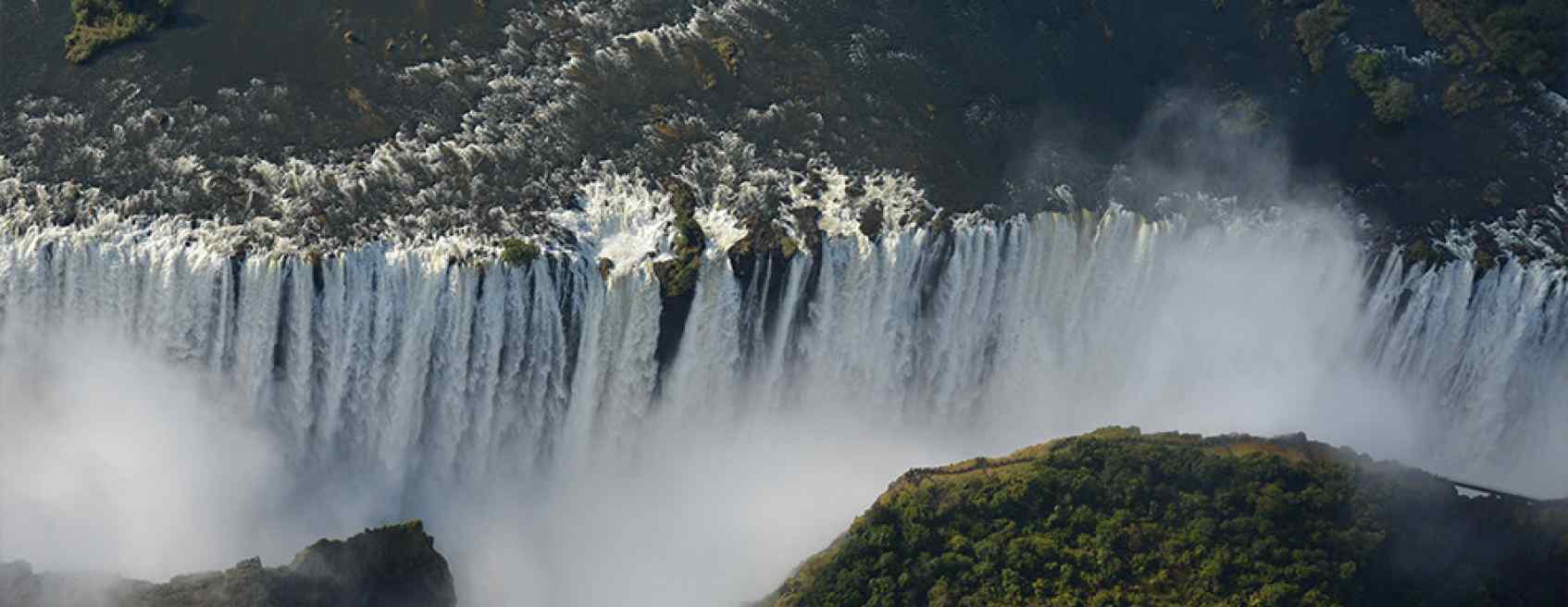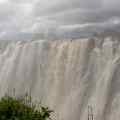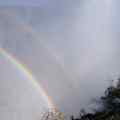Victoria Falls
Mosi-oa-Tunya

Dr David Livingstone, the Scottish missionary and explorer, is believed to have been the first European to view the Victoria Falls which he did from what is now known as ‘Livingstone Island’ in Zambia, the only land accessible in the middle of the falls David Livingstone gave the falls the name ‘Victoria Falls’ in honour of his Queen, but the indigenous name of ‘Mosi-oa-Tunya’ literally meaning the ‘Smoke that Thunders’ is also well known. The World Heritage List recognizes both names.
While it is neither the highest nor the widest waterfall in the world, it is claimed to be the largest. This claim is based on a width of 1,708 meters (5,604 ft) and height of 108 meters (354 ft), forming the largest sheet of falling water in the world. The falls’ maximum flow rate compares well with that of other major waterfalls For a considerable distance upstream from the falls, the Zambezi flows over a level sheet of basalt, in a shallow valley bounded by low and distant sandstone hills. The river’s course is dotted with numerous tree-covered islands, which increase in number as the river approaches the falls. There are no mountains, escarpments, or deep valleys which might be expected to create a waterfall, only flat plateau extending hundreds of kilometres in all directions.
The falls are formed as the full width of the river plummets in a single vertical drop into a transverse chasm 1708 meters (5604 ft) wide, carved by its waters along a fracture zone in the basalt plateau. The depth of the chasm, called the First Gorge, varies from 80 meters (260 ft) at its western end to 108 meters (354 ft) in the centre. The only outlet to the First Gorge is 110 meters (360 ft) wide gap about two-thirds of the way across the width of the falls from the western end, through which the whole volume of the river pours into the Victoria Falls gorges.
There are two islands on the crest of the falls that are large enough to divide the curtain of water even at full flood: Boaruka Island (or Cataract Island) near the western bank and Livingstone Island near the middle the place that David Livingstone first saw the falls from in Zambia. At less than full flood, additional islets divide the curtain of water into separate parallel streams. The main streams are named, in order from Zimbabwe (west) to Zambia (east): Devil’s Cataract (called Leaping Water by some), Main Falls, Rainbow Falls (the highest) and the Eastern Cataract
The Zambezi basin above the falls experiences a rainy season from late November to early April, and a dry season the rest of the year. The river’s annual flood season is February to May with a peak in April The spray from the falls typically rises to a height of over 400 meters (1,300 ft), and sometimes even twice as high, and is visible from up to 50 km (31 mi) away. At full moon, a “moon bow” can be seen in the spray instead of the usual daylight rainbow. During the flood season, however, it is impossible to see the foot of the falls and most of its face, and the walks along the cliff opposite it are in a constant shower and shrouded in mist. Close to the edge of the cliff, spray shoots upward like inverted rain, especially at Zambia’s Knife-Edge Bridge As the dry season takes effect, the islets on the crest become wider and more numerous, and in September to January up to half of the rocky face of the falls may become dry and the bottom of the First Gorge can be seen along most of its length. At this time it becomes possible (though not necessarily safe) to walk across some stretches of the river at the crest. It is also possible to walk to the bottom of the First Gorge at the Zimbabwean side. The minimum flow, which occurs in November, is around a tenth of the April figure; this variation in flow is greater than that of other major falls, and causes Victoria Falls’ annual average flow rate to be lower than might be expected based on the maximum flow.
Victoria Falls is roughly twice the height of North America’s Niagara Falls and well over twice the width of its Horseshoe Falls. In height and width Victoria Falls is rivalled only by South America, Iguazu Falls.








